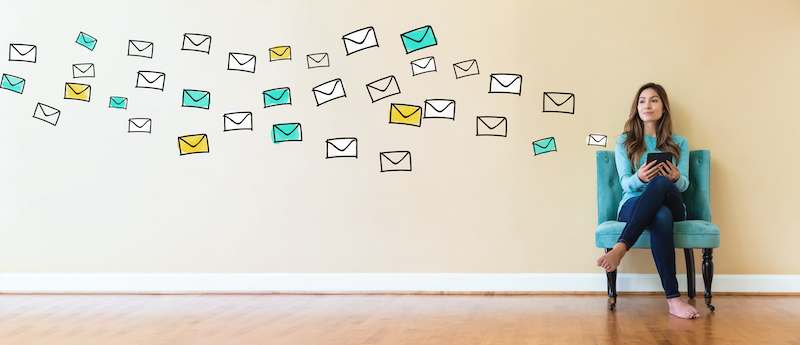Feb. 11, 2022

Email Frequency – How Many Emails Should I Send to My Audience?
This is probably one of the most frequently asked questions I’ve heard in my many years working with email marketing. And by far, I would say it’s one of the common concerns of clients I’ve been working with, afraid of sending too many emails to their subscribers.
So, how many emails should I send to my audience?
Unfortunately, this type of question does not have an answer that applies to all situations.
That said, read the following to understand how you can determine the ideal email frequency in your case.
What Needs to be Understood Before Answering This Question
There are a few components you should consider when determining the frequency of your email calendar.
Define The “Why” Someone Would Like to Join Your Email List
This is a simple concept but an important one to clear things up. In essence, as long as you deliver what you promised when your subscriber decided to sign up, there’s no reason for frequency to be a concern.
The concern arises when it’s unclear and vague why your subscribers are on your list.
Healthy email lists should be composed of people who have expressed an ongoing interest in receiving your content while what you offer aligns with their needs.
To envision what this would look like in practice, ask yourself:
- First, what are my subscriber’s expectations after completing the sign-up?
- Next, what are my subscriber’s expectations after a month on my email list?
- Finally, once converted into customers, what would their expectations be?
Note that the questions above do not seek answers related to frequency. Instead, they focus on “what” you, as a sender, must deliver to be relevant to your subscribers.
Don’t forget, a clear understanding of the “why” precedes the “how many should I send?”
Building Relationships With Email
Similar to any other human interaction, the same rules for building relationships apply to email marketing.
Let’s imagine you just met someone at an event today. You wouldn’t send multiple messages over the next few days. It’s a question of common sense.
On the other hand, you are likely to be forgotten if you only show up a few times. People need to see your email frequently in their inboxes, giving them more chances to engage with your content.
Would you build a trusting relationship with someone who contacts you from time to time? Probably not.
You should send more emails than you think, but with the necessary common sense as if you were building a relationship with someone.
Tips to Determine the Ideal Email Frequency
You might consider some criteria when determining how many emails you’ll be sending.
Email Frequency Based on Your Sales Cycle
Your sales funnel can provide great insights into determining how many emails you should send.
If you are clear about the “why” someone would join your email list, think about how long it takes, on average, for your subscribers to convert into customers.
If each conversion occurs typically in a month, you may consider a weekly email or, in some circumstances, maybe two or even three emails per week.
On the other hand, if an average conversion occurs in three months or more, you may need to space out our email campaigns, giving your prospects enough time to digest your content and build trust in you.
A sales cycle analysis will also determine the number of email sequences you might include in your email program, the number of emails in each series, and the interval between each email.
Balancing Your Content Calendar
A content calendar is crucial to giving you a clear view of how often you will email and what type of content you will share.
I like to think that each email has a different role to play each time you send it. For example, some emails should teach your prospects about something they don’t know. Others should ask for the sale.
Again, similar to building a relationship with someone, you will increase your chances of success by delivering something different on each new interaction, addressing a different area of focus that may be preventing them from making a decision.
Nurturing content is critical to educating your audience around your unique offering and selling proposition—the reason why someone will buy from you.
In addition, consider sales campaigns to encourage your subscribers to take action, moving them through your sales funnel.
With a balanced content calendar, you will position your brand to establish a long-term relationship, away from the perception that you are only in contact to make sales.
The Value of Your Emails
Finally, going back once again to the initial question of why someone joined your email list, the quality of the delivered content matters.
Suppose you share relevant and exciting content, creating an expectation in your subscriber about when you will send a new email. In this scenario, frequency is the last criteria your audience will consider to qualify your brand as annoying, unsubscribing from your list.
Good email marketing is based on the quality you deliver as a sender. The email frequency will support you in building a conversation with your audience providing what they want to see.
Remember: 95% of your leads would not be ready to buy from you on their first interaction with your brand. Therefore, the email frequency that you will determine in your content calendar should respond to their objections, making them ready to buy from you according to where they are in your sales funnel.
If you have any questions regarding email frequency, contact us today!
Read More
Read More About
Book with us
Let’s accomplish what you are looking for, our team of experts are here for you.
Let's work togetherWarning: Working with our team may result in excessive creativity, uncontrollable 'aha' moments, and an addiction to perfect pixels. Please proceed with caution.



